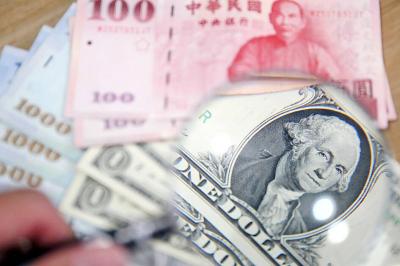Just a few years ago, the millennial generation — generally defined as those born from the early 1980s through the mid-1990s — was synonymous with youthful rebellion. However, now, as the millennials ease into early middle age, they are finding their path out of their parents’ basement to be a lot harder than it was for earlier generations.
The fundamental problem is that millennials are not building wealth. The wealth of the median US household headed by someone 35 or younger has actually shrunk in inflation-adjusted terms since the mid-2000s, even as the wealth of older Americans has continued to grow.
An analysis by the Center for Household Financial Stability at the Federal Reserve Bank of St Louis found that millennials have 34 percent less wealth than would have been predicted from the experience of earlier generations. The gap is much larger for those without a bachelor’s degree.

Photo: Reuters
Many analysts have zeroed in on housing as the reason millennials have failed to match their predecessors.
As of last year, millennials owned only 5 percent of the US housing stock, compared with 15 percent for the previous generation at the same age.
The homeownership rate for households headed by Americans younger than 35 was 43 percent in 2005, but only 31 percent in 2015. Instead of accumulating mortgage debt like their predecessors, they have racked up student loans and consumer debt.
Of course, millennials will eventually inherit their baby boomer parents’ wealth, including houses.
However, much of this transfer will not happen for another decade or two, meaning that many millennials will pass through their prime family-forming years without the stability and life options that wealth and homeownership provide. That is already weighing on fertility rates, exacerbating the problem of population aging.
Furthermore, inherited wealth would perpetuate stark racial disparities, with black and Hispanic millennials in the US receiving little compared with their white peers.
A large fraction of millennials are thus on track to be a sad and lost generation, too old for the young rebellious independent bohemian life, but too poor and indebted to move to the suburbs and start families. The US government needs to think about policies to prevent this from happening.
The most obvious policy is to cancel some of the existing stock of student-loan debt — most of which is owned by the federal government — and to switch to an income-based repayment model for future student loans.
However, this would primarily help educated millennials, who are not as far behind in terms of wealth-building as those without a bachelor’s degree.
Another option is to implement wealth taxes and hand the money out as basic income. However, income takes a long time to turn into wealth, even if the recipients save much of what they get.
The best method for building broad-based middle-class wealth is still homeownership. Houses are a physical, tangible asset that people of all walks of life can understand and feel confident in.
Unlike other forms of wealth, a mortgage also nudges people toward saving more of their income. This is probably why the middle class tends to hold most of its wealth in houses.
The US used to facilitate mass wealth-building via homeownership. The GI Bill helped World War II veterans buy homes en masse, and the expansion of the suburbs gave them and the boomers who followed plenty of new homes to buy.
However, those homes have appreciated in price and nationwide construction has stalled, leaving many millennials priced out of the market amid a slow-growing stock of housing.
Today, US housing, rather than a driver of wealth accumulation, has become an engine of intergenerational inequality.
Some countries have done a better job than the US of using housing to build and transfer wealth across generations. One of these is Singapore. Although most of Singapore’s housing is government-built and is technically government-owned, the government allows occupants to buy and sell 99-year leases that essentially function as title deeds. Homeownership, therefore, is near-universal.
The Singaporean government also gives out subsidies to help young families buy starter homes. Because the government manages the supply of new homes, it can ensure that young people earn a decent return by the time they retire.
The US could adapt this system to promote mass homeownership and wealth creation for millennials and later generations. The government could build and sell new housing, especially in inner-ring suburbs, potentially using eminent domain to keep construction costs low. Young people — especially young families — could get down-payment assistance to buy their first home.
By carefully managing the amount of new housing construction, the government could make sure that home prices appreciated enough to provide people with a decent return over their lifetime, but not too much to price younger people out of the market.
Each generation would thus get to enjoy what the WWII generation and boomers enjoyed — the security and personal freedom of owning a home at a young age, coupled with the knowledge that their wealth would appreciate over time.
Because down-payment assistance would be funded by progressive taxation, the system would redistribute wealth to those who were not born with rich parents.
The alternative — letting young Americans reach middle age without a stake in the US economic system — is both sad and frightening to contemplate, because it could lead not just to ennui but to unrest.
A housing system built loosely on the Singaporean model would allow today’s young people to enjoy the same life progression as their parents and grandparents, preserving the American dream in perpetuity.
Noah Smith is a Bloomberg Opinion columnist. He was an assistant professor of finance at Stony Brook University and he blogs at Noahpinion.
This column does not necessarily reflect the opinion of the editorial board or Bloomberg LP and its owners.

The US dollar was trading at NT$29.7 at 10am today on the Taipei Foreign Exchange, as the New Taiwan dollar gained NT$1.364 from the previous close last week. The NT dollar continued to rise today, after surging 3.07 percent on Friday. After opening at NT$30.91, the NT dollar gained more than NT$1 in just 15 minutes, briefly passing the NT$30 mark. Before the US Department of the Treasury's semi-annual currency report came out, expectations that the NT dollar would keep rising were already building. The NT dollar on Friday closed at NT$31.064, up by NT$0.953 — a 3.07 percent single-day gain. Today,

‘SHORT TERM’: The local currency would likely remain strong in the near term, driven by anticipated US trade pressure, capital inflows and expectations of a US Fed rate cut The US dollar is expected to fall below NT$30 in the near term, as traders anticipate increased pressure from Washington for Taiwan to allow the New Taiwan dollar to appreciate, Cathay United Bank (國泰世華銀行) chief economist Lin Chi-chao (林啟超) said. Following a sharp drop in the greenback against the NT dollar on Friday, Lin told the Central News Agency that the local currency is likely to remain strong in the short term, driven in part by market psychology surrounding anticipated US policy pressure. On Friday, the US dollar fell NT$0.953, or 3.07 percent, closing at NT$31.064 — its lowest level since Jan.

The New Taiwan dollar and Taiwanese stocks surged on signs that trade tensions between the world’s top two economies might start easing and as US tech earnings boosted the outlook of the nation’s semiconductor exports. The NT dollar strengthened as much as 3.8 percent versus the US dollar to 30.815, the biggest intraday gain since January 2011, closing at NT$31.064. The benchmark TAIEX jumped 2.73 percent to outperform the region’s equity gauges. Outlook for global trade improved after China said it is assessing possible trade talks with the US, providing a boost for the nation’s currency and shares. As the NT dollar

The Financial Supervisory Commission (FSC) yesterday met with some of the nation’s largest insurance companies as a skyrocketing New Taiwan dollar piles pressure on their hundreds of billions of dollars in US bond investments. The commission has asked some life insurance firms, among the biggest Asian holders of US debt, to discuss how the rapidly strengthening NT dollar has impacted their operations, people familiar with the matter said. The meeting took place as the NT dollar jumped as much as 5 percent yesterday, its biggest intraday gain in more than three decades. The local currency surged as exporters rushed to